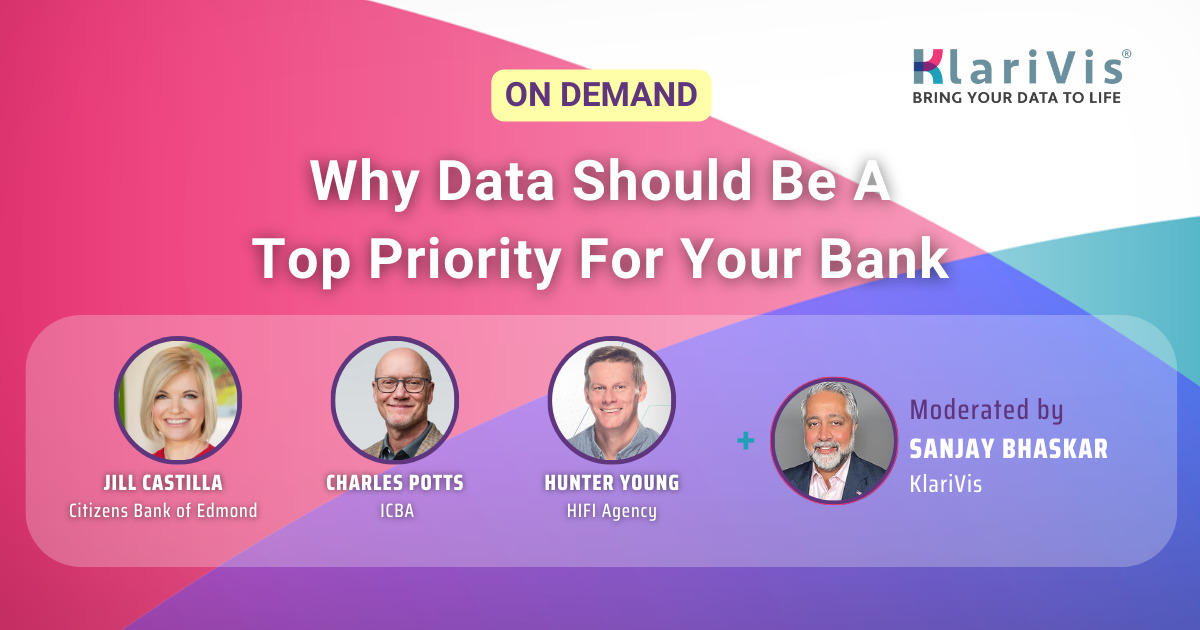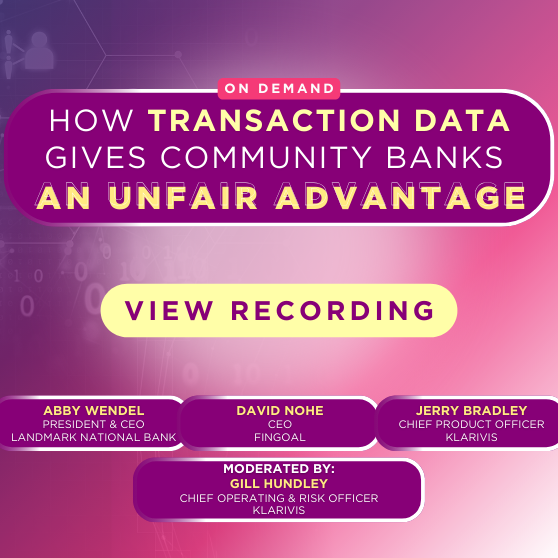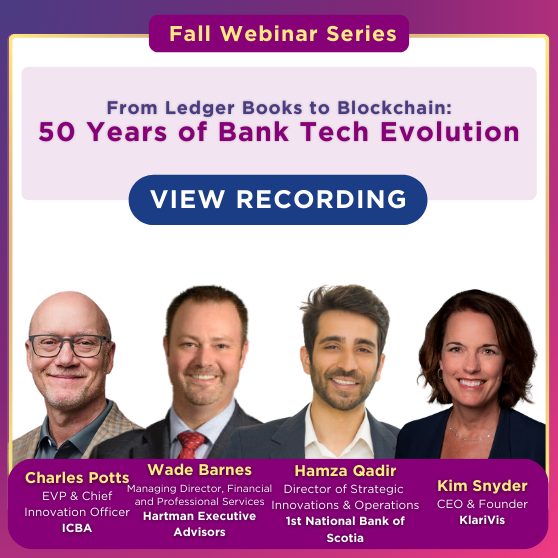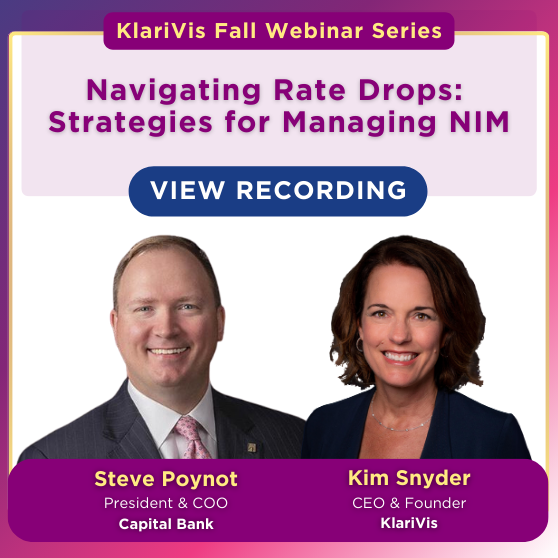The browser you are using is not supported. Please consider using a modern browser.
Webinar
WATCH: Why Data Should Be A Top Priority For Your Bank
Recorded Feb 22, 2023
Speakers Include
-

Sanjay Bhaskar
KlariVis
-

Jill Castilla
Citizens Bank of Edmond
-

Charles Potts
ICBA
-

Hunter Young
HIFI Agency

Why Data Should Be A Top Priority For Your Bank
KlariVis’ Chief Revenue Officer Sanjay Bhaskar sat down with industry experts to discuss why data should be a top priority for community banks.
Jill Castilla, President and CEO of Citizens Bank, joined Charles Potts, EVP & Chief Innovation Officer of the ICBA, and Hunter Young, Founder & President of HIFI Agency and former banker, to explore why data is the key to bank transformation.
Here is a recap of their discussion:
What is the biggest challenge you see for community financial institutions today when it comes to data?
Potts points to several major challenges. First, the overwhelming majority of banks say they lack a clear data strategy. Even with a strategy, many banks do not know where most of their data resides, and they lack the necessary tools to put their data to use.
Castilla adds that a primary challenge for banks is not a lack of data, but rather the ability to segment and analyze it. Like Potts, she points out that a major hurdle banks face is a lack of both the tools and talent to find and digest data, use it appropriately to predict customer behavior, then take necessary steps to implement the right strategies that ensure the organization’s success.
Ongoing talent wars add another layer of complexity. Finding and retaining the right talent has been a challenge across almost all industries, and community financial institutions are no exception, especially for data teams and analysts.
How has the data strategy changed for banks over the last five years? What will change over the next five years?
According to Potts, the experiences the banking industry faced during the pandemic magnified and accelerated the already-building disintermediation from new players entering the market who not only had a data strategy, but an unincumbered technology stack. As a result of global lockdowns, the mobile-first approach that was already growing quickly accelerated to a level that was challenging for community banks to match. This trend has been driven by frictionless data strategies and it’s only growing more rapidly.
Young agrees, emphasizing that fintech disintermediation has been an important trend, with COVID acting as an accelerant. Today, however, gaps in fintechs’ strategies are starting to come to light. The next several years may be a significant opportunity for community financial institutions to recapture market share and capitalize on their long-standing reputation for relationship-centric banking. Data will be a critical part of that, allowing banks to tap into the customer’s full financial relationship that fintechs may have missed.
“The data that banks have is really the key to understanding, where did they [customers] go,” says Potts. Banks can then identify what they have that those customers need or want.
Castilla adds, “Nothing produces innovation and change like war.” Banks constantly experience battles, whether it’s COVID, the financial crisis or ongoing coopetition.
Citing Sun Tzu’s The Art of War, Castilla points out that you must know the enemy and yourself to succeed. Data is all about knowing yourself. Without it, community financial institutions have no chance of “winning the war,” she says.
Castilla points to two examples: During the pandemic, data helped banks identify which customers needed support first, and in the financial crisis, banks analyzed data to see what loans were at a greater risk of default. However, she cautions that these aren’t the only battles banks will face; there will be more.
How can community financial institutions use data to mitigate economic risks?
Amid ongoing rate hikes, mortgage lending is drying up for many financial institutions and acquiring and retaining deposits is becoming a greater priority. Banks will be increasingly challenged by economic factors.
Castilla says that now is a critical time to identify your bank’s competitive advantages. Banks may mistakenly think they know, but data is critical to reveal true strengths. Banks also need to intently understand and analyze the composition of their deposits. This will be critical in the months ahead.
Potts adds that community banks should not only identify strengths but leverage data to shore up weaknesses. He urges banks to take a deeper look at their portfolios and leverage data in a way to create predictive early warning systems.
Young agrees that banks must identify and play to their strengths, especially as it pertains to their future. Retention will continue to be a priority and banks must identify potential niches that are most advantageous based on their strengths.
Data also allows banks to move at a faster pace. Castilla points out that community financial institutions worked extremely hard during the PPP era, but they need to keep working at that same pace moving ahead. Otherwise, they risk losing out.
To do so, banks need data to quickly assess what’s working and what’s not. They can also no longer be held to lengthy contracts with fintechs. Community financial institutions must be able to shift and pivot with greater agility.
If you had one game-changing data point, what would it be?
Castilla says customer spending compared to savings. She notes that big banks have this type of data, but such level of granularity is practically impossible for community financial institutions.
The ability to see consumer behaviors as their income increases or decreases allows banks to predict how customers may react to certain economic issues. This will be increasingly powerful amid economic uncertainty as well as recovery.
How can data help improve the customer experience?
Young encourages banks to look at channel engagement to guide tech spending decisions. Data can show potential opportunities or reveal areas that should be deprioritized.
Castilla agrees, pointing to her bank as an example. Citizens Bank was not seeing high engagement at one of its branches compared to ATMs. Based on its data, the bank replaced that branch with ITMs to support a better customer experience.
An important element to customer engagement is being able to create a more frictionless experience, according to Potts. It’s about being where the customer is and delivering consistent experiences across all channels. Data can inform these factors.
Specific to Citizens Bank, what were you trying to solve that KlariVis supports?
Castilla says that partnering with KlariVis is a big opportunity for them. Previously, the bank was extrapolating data and then manually building systems to appropriately analyze that data. This manual process was extremely time-consuming, requiring hours of the CFO’s time each month.
With KlariVis, they can automate and systemize this process, and instead allocate their time to analyzing the data to inform and empower strategic decisions.
“If I can leverage technology to then be able to create growth opportunities for my CFO – who is wildly talented and enthusiastic to learn – and then be able to get better and more consistent data that I can easily manipulate and access through all types of means, it’s a no-brainer for us,” says Castilla.
Castilla adds, “Our philosophy is – we implement things that are not heavy lifts for us. If it’s not going to be a heavy resource lift, it’s not going to be a heavy cost lift, but it’s going to have an impact, then let’s do that. If the risk is low and the resource investment is low, then let’s lean into it and do it. It was easy from an implementation standpoint, cost effective and allows for some specific growth opportunities for our current team.”
Consumers today have more than one financial relationship. How do community financial institutions manage their relationship while that customer is using other banking services and providers?
Potts says that banks and their leadership teams must have an overt, thoughtful strategy. They must understand what they do well and address deposit leakage.
If a customer has multiple deposit solutions, the bank must know where that customer’s money is going. He recommends that every bank needs to sit down and conduct a deposit leakage analysis, and then build the appropriate strategy.
A data strategy can be overwhelming. What are your recommendations to someone getting started?
“Shred your spreadsheets,” said Young. Joking aside, he says banks must first refine their processes, including where tasks can be automated and systemized. Manual spreadsheets are a natural place to start.
Castilla adds that it requires a cultural change. Banks must think about how to create efficiencies and build strategies around that. For instance, how does a bank move from paper to paperless?
Building on Young’s advice, she encourages banks to look at their spreadsheets and consider areas to automate. She says banks must look for opportunities to speed processes and create efficiencies, and they must include their teams in this process. It must be clear that change isn’t necessarily about replacing staff or monitoring employees’ jobs. It’s about helping them do their jobs better and more efficiently.
Castilla also says that if you’re going to be innovative, you also need to be comfortable with failing. “The enemy of innovative is perfection,” she says. There is no way to achieve both. Banks have to stumble forward.
Potts adds that it’s also about empowering team members to ask important questions on why the bank is doing things a certain way and then identify better ideas.
How can banks get buy-in?
“So much depends on having a couple of champions,” says Castilla. Authentic buy-in from a handful of employees is critical. Naturally, others will be encouraged.
Potts reiterates the importance of making employees feel empowered and feeling safe at failing. This will ultimately encourage employees to try new ideas.
Young adds that banks should turn their data initiative into a story. “Data feels messy and cold,” he says. Making it tangible and connecting it to real results is important and powerful to encouraging buy-in.


